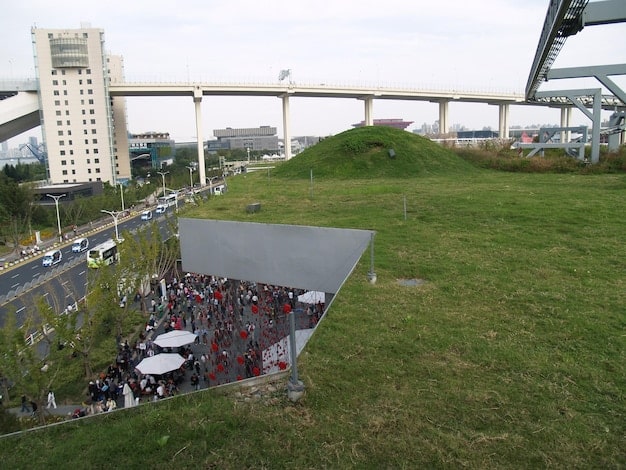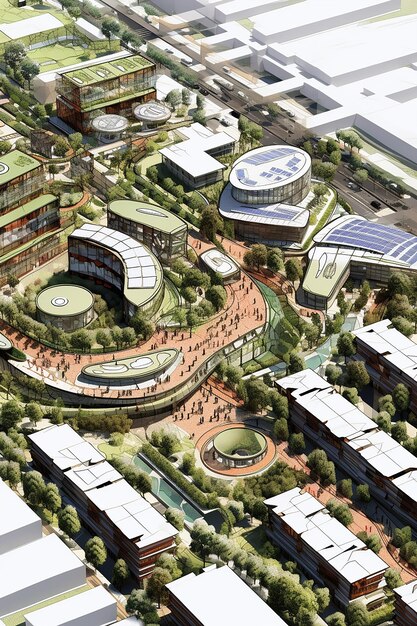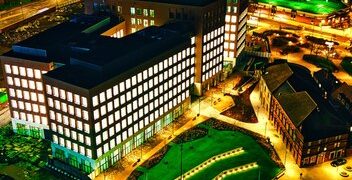World Cup 2026 Stadium Legacy: Future Plans Explained

After the final whistle of the 2026 World Cup, host cities are focusing on sustainable legacy plans for their newly built or renovated stadiums, aiming for long-term community benefits and economic viability beyond the tournament euphoria.
As the anticipation builds for the 2026 FIFA World Cup, jointly hosted by the United States, Canada, and Mexico, a pivotal question emerges beyond the spectacle of the matches: World Cup 2026: What are the Legacy Plans for Stadiums After the Tournament? This question delves into the complex strategies being developed to ensure these massive infrastructures serve a purpose long after the final whistle blows, transforming potential white elephants into enduring community assets.
Understanding the World Cup Legacy Challenge
Hosting a major international event like the FIFA World Cup brings immense spotlight, economic opportunities, and national pride. However, it also presents a significant challenge: what happens to the extensive infrastructure, particularly the stadiums, once the event concludes? The concept of “legacy” has evolved beyond mere physical structures to encompass economic, social, and environmental sustainability.
The history of mega-events is replete with examples of both success and failure in legacy planning. From the repurposing of Olympic villages into housing to stadiums becoming underutilized burdens, the blueprint for 2026 must learn from past experiences. This World Cup, spread across an unprecedented three nations and 16 host cities, intensifies the focus on diverse, context-specific legacy strategies.
Past Lessons and Future Vision
Examining previous World Cups offers valuable insights. Brazil’s 2014 World Cup, for instance, faced criticism for several “white elephant” stadiums that struggled to find viable post-tournament uses. On the other hand, Germany’s 2006 World Cup is often cited as a success story, where stadiums were meticulously integrated into existing club football infrastructure or repurposed for multi-sport and entertainment events. The vision for 2026 leans heavily on proactive planning, community engagement, and multi-stakeholder collaboration to avoid similar pitfalls and maximize long-term benefits.
- Germany 2006: Utilized existing robust club football infrastructure, ensuring sustained usage.
- South Africa 2010: Mixed results, with some venues finding new life in rugby or concerts, others facing underutilization.
- Brazil 2014: High-profile instances of stadiums struggling to attract consistent events, leading to costly maintenance.
- Russia 2018: Post-event usage varied, with some stadiums repurposed for local teams, others requiring significant government subsidization.
The focus for 2026 is on leveraging venues that are already established or undergoing upgrades, rather than building from scratch. This approach significantly reduces the risk of white elephants, as existing demand from professional sports teams, concerts, and other large-scale events provides a crucial foundation for post-tournament viability. It’s about enhancing, not just erecting.
Moreover, the distributed nature of the tournament across three countries means that host cities can tailor their legacy plans to their unique local contexts and needs. This decentralization fosters a more agile and responsive planning process, moving away from a one-size-fits-all approach. Each city’s strategy will reflect its economic priorities, existing sports landscape, and community aspirations, thereby increasing the likelihood of successful, sustainable legacies.
USA Host City Stadium Legacy Strategies
The United States, with its robust professional sports landscape, presents a unique set of opportunities for stadium legacy. Many of the chosen venues are already home to NFL teams, Major League Soccer (MLS) clubs, or are designed as multi-purpose arenas, which inherently aids post-tournament usage. The primary focus for these stadiums is not radical transformation but rather strategic enhancement and diversification of revenue streams.
Cities like Atlanta, Dallas, and Seattle boast modern venues (Mercedes-Benz Stadium, AT&T Stadium, Lumen Field) that are already pillars of their respective sports and entertainment ecosystems. For them, the World Cup means a temporary uplift, followed by a return to their established roles, possibly with upgraded facilities that can attract even more diverse events, from international friendlies to major concert tours. The upgrades are often minor, focusing on pitch conditions, media facilities, and fan experience enhancements, rather than structural overhauls.
Diversifying Post-Tournament Usage
The key to a successful legacy in the US lies in diversifying how these stadiums are used. It extends beyond professional sports to include a wide array of activities:
- Concerts and Live Events: Major stadiums are increasingly becoming a cornerstone of the live music industry, attracting global artists and large-scale festivals. The enhanced visibility from the World Cup can boost their appeal.
- Conferences and Exhibitions: Larger venues can host major corporate events, trade shows, and conventions, leveraging their large capacities and existing infrastructure.
- Community Use and Amateur Sports: Some stadiums, or their auxiliary facilities, might be opened for community events, youth sports tournaments, or even local fitness initiatives, fostering broader community engagement.
- Economic Development Hubs: The surrounding areas of stadiums often see development in hospitality, retail, and entertainment. Legacy plans often include continued investment in these areas, creating permanent jobs and stimulating local economies.
For cities like Kansas City or Philadelphia, whose stadiums are primarily NFL venues, the World Cup offers a chance to showcase their capabilities on a global stage, potentially attracting more international events in the future. The existing high demand for these venues from their primary tenants (NFL teams) provides a significant buffer against underutilization. The critical factor is maximizing the exposure and temporary upgrades to secure long-term, diverse event bookings, ensuring that the initial investment in hosting delivers sustained returns for the local economy and community.

Canada’s Approach to Stadium Sustainability
Canada’s two chosen host cities, Toronto and Vancouver, present distinct scenarios for stadium legacy. Both cities are major metropolitan centers with established sports cultures, yet their stadium situations differ, paving the way for unique sustainability plans. The overarching theme for Canada is leveraging existing, well-utilized venues and integrating World Cup enhancements into long-term urban development and community benefit schemes.
BC Place in Vancouver is already a multi-purpose indoor stadium, home to MLS’s Vancouver Whitecaps FC and CFL’s BC Lions. Its significant renovations over the past decade already positioned it as a premium event space. For the World Cup, the focus is on minor operational enhancements and ensuring the pitch meets FIFA standards. The legacy will primarily be a reaffirmation of BC Place’s status as a premier venue for major sports and entertainment events in Western Canada, building on its existing high usage.
Toronto’s BMO Field Expansion
Toronto’s BMO Field, home to MLS’s Toronto FC and CFL’s Toronto Argonauts, requires significant expansion to meet FIFA’s capacity requirements. This expansion, however, is being framed as an investment with a long-term payoff beyond the World Cup itself. The larger capacity and upgraded facilities will allow BMO Field to host a broader range of major events in the future, including potential bids for other international soccer tournaments, major concerts, and even colder weather NFL games or college football. The strategy aligns with Toronto’s growth as a major North American sports and entertainment hub.
- BMO Field (Toronto): Expansion driven by strategic intent to host more varied, large-scale events post-World Cup, bolstering its continuous economic impact on the city beyond regular league play.
- BC Place (Vancouver): Minimal physical changes, focusing on operational readiness and solidifying its reputation as a preferred venue for top-tier international events and entertainment.
For both Canadian venues, the legacy is deeply intertwined with urban planning initiatives. Investments in transport links, fan zones, and surrounding commercial areas are designed to provide lasting benefits. This approach ensures that the World Cup footprint extends beyond the stadium walls, contributing to the broader economic and social fabric of the cities. The planning prioritizes multi-use functionality and year-round utilization, preventing the venues from becoming idle assets. Furthermore, there is a strong emphasis on community access and programming in the post-tournament phase, linking the World Cup to grassroots sport development and public engagement initiatives, thereby creating a truly inclusive legacy that benefits a wide segment of the population.
Mexico’s Legacy Model: Tradition Meets Modernity
Mexico, a three-time World Cup host, brings a unique blend of historical significance and a passionate football culture to the 2026 tournament. Its chosen venues – Estadio Azteca in Mexico City, Estadio BBVA in Monterrey, and Estadio Akron in Guadalajara – represent a spectrum from iconic heritage to modern architectural marvels. The legacy plans for these stadiums balance reverence for tradition with an eye towards future sustainability and expanded utility.
Estadio Azteca, the only stadium to have hosted two World Cup finals (1970, 1986), is undergoing significant renovation rather than a complete overhaul. The legacy here is about preserving its historical significance while upgrading it to contemporary standards for fan comfort, media facilities, and operational efficiency. Post-2026, it will continue as the home of Club América and the Mexican national team, solidifying its place as a football cathedral ensuring a guaranteed high level of post-tournament usage.
Modern Venues and Diverse Applications
Estadio BBVA and Estadio Akron are relatively newer, purpose-built football stadiums that are already considered among the best in Latin America. Their legacy strategies focus less on physical transformation and more on leveraging the World Cup exposure to attract a wider array of events beyond regular club football. These include major international concerts, non-football sporting events, and large-scale cultural gatherings, allowing these stadiums to maximize their year-round economic contribution.
- Estadio Azteca (Mexico City): Renovation to preserve historical value while upgrading for modern functionality and continued use by major football clubs.
- Estadio BBVA (Monterrey): Leveraging World Cup exposure to attract more diverse international events, cementing its status as an entertainment hub in the region.
- Estadio Akron (Guadalajara): Continued focus on multi-use capabilities, enhancing its role in the region’s sports and entertainment landscape, supporting both club and other major events.
For Mexico, the World Cup is also an opportunity to invest in surrounding infrastructure, such as public transport and hospitality, which will have a lasting positive impact on the host cities. The deep-rooted football culture in Mexico ensures that the stadiums will maintain high levels of usage post-tournament, primarily for Liga MX matches. The challenge lies in diversifying their use to attract non-football events, ensuring they are not solely reliant on the sport for their economic viability. This multi-faceted approach, combining respect for football heritage with a forward-looking view on event diversification and urban development, aims to leave a robust and beneficial legacy for Mexican host cities.
Economic and Social Impact Beyond the Pitch
The legacy of the World Cup stadiums extends far beyond the structures themselves, encompassing profound economic and social impacts on host communities. These impacts are a critical component of legacy planning, influencing everything from urban development to community well-being. A successful legacy means harnessing the momentum of the tournament to create lasting benefits that improve the quality of life for residents long after the final match.
Economically, the World Cup can serve as a catalyst for investment. Beyond direct stadium upgrades, host cities often see significant private and public investment in related infrastructure, such as transportation networks, hotels, and tourist attractions. This investment creates temporary and permanent jobs, stimulates local businesses, and enhances the overall economic vibrancy of the region. The increased global visibility from hosting the tournament can also attract future tourism and foreign investment, leading to long-term economic growth.
Community Engagement and Urban Regeneration
Socially, the World Cup can foster a sense of civic pride and unity. Legacy programs often include plans for community access to enhanced sports facilities, youth development programs, and cultural events that leverage the tournament’s momentum. This can promote active lifestyles, develop local talent, and strengthen community bonds. In some cases, stadium projects can even drive urban regeneration, revitalizing previously underdeveloped areas and creating new public spaces.
- Job Creation: Both temporary during construction/tournament, and permanent in hospitality, retail, and stadium management.
- Tourism Boost: Increased global recognition attracting more visitors in the years following the event.
- Infrastructure Development: Upgrades to transport, utilities, and public spaces benefiting all residents.
- Community Programs: Investment in grassroots sports, education, and cultural initiatives leveraging the World Cup spotlight.
However, realizing these benefits requires careful and inclusive planning. Consultation with local communities is crucial to ensure that legacy projects address genuine needs and avoid displacement or gentrification. Success depends on truly integrating the stadium into the urban fabric and ensuring that the economic gains are broadly distributed. By prioritizing sustainable development and community well-being alongside economic returns, the 2026 World Cup aims to set a new benchmark for creating enduring legacies that resonate far beyond the sporting arena, making a tangible difference in the lives of the people who call these host cities home.
Challenges and Sustainable Solutions
Despite meticulous planning and ambitious goals, the path to a successful stadium legacy for the 2026 World Cup is not without its challenges. Chief among these is the risk of underutilization and the financial burden of maintaining colossal structures designed for intermittent mega-events. The diverse economic and urban contexts of the 16 host cities across three nations mean that a one-size-fits-all solution is neither practical nor effective. Each city must grapple with its unique set of circumstances, from local sporting preferences to existing infrastructure capacities.
A primary challenge for many stadiums, even those with primary tenants, is ensuring year-round economic viability. Large venues often require significant resources for maintenance, security, and staffing, which can become a drain if not consistently offset by revenue-generating events. This is particularly true for stadiums that do not regularly host major professional sports or have a limited calendar of large-scale concerts.
Innovative Approaches to Viability
However, host cities and stadium operators are increasingly adopting innovative solutions to tackle these challenges. These include:
- Multi-functional Design: Building or renovating stadiums with flexible seating configurations, adaptable spaces, and integrated commercial areas that can be used for diverse events, from sporting contests to conventions and community meetings. This adaptability greatly enhances their long-term appeal.
- Technology Integration: Implementing smart stadium technologies for energy efficiency, enhanced fan experience, and streamlined operations, reducing long-term operational costs and increasing attractiveness.
- Partnerships and Diversification: Forging strategic partnerships with event promoters, cultural organizations, and local businesses to guarantee a steady stream of diverse events and revenue sources beyond traditional sports. This proactive approach helps fill the calendar and drive sustained economic activity.
- Community Integration: Making parts of the stadium or its surrounding complex accessible for public use, such as fitness centers, public parks, or educational facilities, thereby turning them into community assets rather than exclusive sports venues. This deepens community ties and justifies public investment.
The emphasis for the 2026 World Cup legacy aims to be on resilience and adaptability. By anticipating potential pitfalls and proactively developing diversified utilization strategies, the host nations intend to set a new standard for mega-event legacies. This involves transparent governance, continuous stakeholder engagement, and a commitment to long-term sustainability that goes beyond the immediate economic gains of the tournament, ensuring that the stadiums serve as enduring symbols of progress and community benefit.
The Role of E-E-A-T in Legacy Planning
In the context of the 2026 FIFA World Cup, where billions of dollars are invested and millions of lives are impacted, the principles of E-E-A-T (Experience, Expertise, Authoritativeness, Trustworthiness) are not just critical for information credibility but are fundamental to the success and sustainability of legacy planning. The very nature of creating a lasting, beneficial legacy for stadiums demands a high level of reliable process, verifiable experience, and transparent decision-making that can stand up to scrutiny.
Experience in legacy planning for mega-events is paramount. The organizing committees and host cities are drawing lessons from previous World Cups and Olympics, both successes and failures, to inform their strategies. This involves learning from Brazil’s challenges with “white elephants” and emulating Germany’s successful integration of stadiums into existing infrastructure. This collective experience guides decisions on stadium design, funding models, and post-tournament utilization, ensuring that past mistakes are not repeated.
Expertise and Trustworthiness
Expertise is derived from the involvement of multidisciplinary teams comprising urban planners, architects, environmental scientists, economists, and sports management professionals. These experts contribute specialized knowledge to develop comprehensive plans that address not only the immediate needs of the tournament but also the long-term socio-economic and environmental impacts. Their informed analysis and projections are crucial for creating viable and sustainable legacy initiatives that extend beyond basic facility management.
Authoritativeness comes from the official bodies and governmental agencies that sanction and oversee the World Cup and its associated projects. The active involvement of entities like FIFA, national football associations, and local municipal governments lends their authority to the legacy plans. This ensures that decisions are made within established frameworks, adhere to international standards, and are supported by the necessary legal and administrative structures. Such endorsement builds confidence in the feasibility and integrity of the plans.
Finally, Trustworthiness is built through transparent communication, accountability, and community engagement. For legacy plans to be truly successful and accepted by the public, there must be clear disclosure of financial commitments, environmental impacts, and projected benefits. Engaging local communities in the planning process, addressing their concerns, and demonstrating a genuine commitment to delivering on promises fosters trust. This includes independent audits, public reports, and accessible information on how stadiums will be utilized and maintained post-tournament. The more verifiable and transparent the planning, the greater the public and investor confidence in the long-term success of the stadium legacy, solidifying its place as a positive contribution to the host regions.
| Key Point | Brief Description |
|---|---|
| 🏟️ Multi-Purpose Design | Stadiums are planned for diverse events beyond football, including concerts and conferences, ensuring year-round use. |
| 📊 Economic Catalyst | Investment in stadiums boosts local economies through job creation, tourism, and infrastructure improvements. |
| 🌱 Sustainability Focus | Plans prioritize environmental and social sustainability, aiming for long-term community benefits. |
| 🤝 Community Integration | Venues are often integrated into urban planning, providing spaces for community activities and engagement. |

Frequently Asked Questions About World Cup 2026 Stadium Legacy
▼
A “white elephant” stadium refers to a large venue built or extensively renovated for a major sporting event that, after the event concludes, becomes largely unused or financially draining to maintain. These stadiums struggle to find sustainable post-event uses, leading to significant economic burdens for host cities. Effective legacy planning aims to prevent such outcomes by ensuring long-term viability.
▼
US stadiums often have existing long-term tenants (like NFL or MLS teams) and are already multi-purpose, requiring fewer major structural changes. Mexican stadiums often blend historical significance with modern upgrades, ensuring continued use for passionate local football leagues. Canadian venues, while also multi-purpose, include significant expansions (like BMO Field) aimed at diversifying future event hosting capabilities, each adapting to their regional contexts.
▼
Host cities expect long-term economic benefits beyond the tournament itself. These include sustained job creation in stadium operations, hospitality, and retail sectors. The enhanced global visibility can attract increased tourism and foreign investment. Additionally, upgrades in public infrastructure related to stadium access and surrounding areas contribute to broader urban economic development and regional competitiveness for future events.
▼
Yes, many legacy plans incorporate elements of community access and usage. While the main stadiums will primarily return to hosting professional sports and large-scale entertainment, efforts are made to integrate them into the community. This can include opening auxiliary facilities for local sports, hosting community events, or developing surrounding public spaces that benefit local residents, fostering a sense of shared ownership and enjoyment beyond just major events.
▼
Environmental sustainability is increasingly a core component of legacy planning. This includes designing or renovating stadiums with energy-efficient systems, water conservation measures, and waste management strategies. The goal is to minimize the ecological footprint of the venues and operations. Furthermore, some plans extend to promoting green transport options to the stadiums and integrating green spaces around the venues, contributing positively to urban ecosystems.
Conclusion
The 2026 FIFA World Cup heralds not just a celebration of global football but also a sophisticated exercise in urban planning and sustainable development. The legacy plans for its stadiums across the United States, Canada, and Mexico reflect a concerted effort to move beyond mere temporary spectacle, ensuring that these monumental venues serve their communities long after the final whistle. By prioritizing multi-purpose design, fostering economic development, and embedding themselves within broader urban regeneration strategies, host cities aim to transform potential challenges into enduring assets. The commitment to learn from past experiences and embrace innovative, adaptable solutions underscores a vital shift towards creating legacies that are truly impactful, economically viable, and socially enriching for generations to come, setting a new benchmark for global sporting events.





